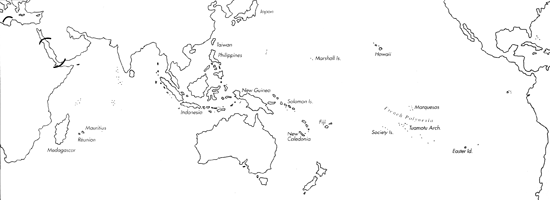Range: Red Sea; recently reported from the Mediterranean Sea (Libya) (R├Čckel, 1986) (Pl. 22, Fig. 25).
Description: Moderately small to moderately large, moderately solid to solid. Last whorl conical to broadly conical; outline convex at adapical third, straight below. Shoulder angulate. Spire of low to moderate height, outline concave to straight. Maximum diameter of larval shell 0.9 mm. Early postnuclear whorls tuberculate. Teleoconch sutural ramps flat to slightly concave, with 1-2 increasing to 4 spiral grooves, finer and more numerous but weak or even obsolete on later ramps. Last whorl with weak or obsolete spiral ribs at base.
| Shell Morphometry | ||
|---|---|---|
| L | 30-69 mm | |
| RW | 0.16-0.40 g/mm | |
| (L 30-51 mm) | ||
| RD | 0.57-0.79 | |
| PMD | 0.85-0.95 | |
| RSH | 0.10-0.19 | |
Ground colour pale grey. Last whorl with a broad grey to brown spiral band on each side of centre, leaving ground-colour bands at centre and at shoulder. Dashed and dotted brown spiral lines may extend from base to shoulder, mainly restricted to colour bands or absent. Base brown, contrasting with paler adjacent area. Larval whorls pale pink or grey. Teleoconch sutural ramps with numerous brown radial markings usually extending to subshoulder area. Aperture translucent, shaded with violet in large specimens.
Habitat and Habits: Shallow water.
Discussion: C. fumigatus resembles C. lischkeanus, C. cumingii and C. splendidulus; for comparison, see the Discussions of the latter species. C. blainvillei (Pl. 22, Figs. 27,28), C. luctificus (Pl. 34, Fig, 21), C. pazii, C. excavatus (Pl. 22, Fig. 29), C. henoquei (Pl. 22, Fig. 30), and C. richardi refer to variants of both colour pattern and shape. Comparing the type specimens and original figures, C. fumigatus and C. pazii refer to rather broad shells (RD 0.70 - 0.73), C. blainvillei is somewhat broader (RD about 0.77), C. henoquei and C. excavatus are somewhat narrower (RD 0.66 - 0.68), while C. luctificus and C. richardi have the narrowest shells (RD 0.61 - 0.62). Specimens as narrow as or narrower than C. richardi are known from the Djibouti area, while specimens as broad as or broader than C. blainvillei occur in the Dahlak Archipelago. Coomans & Moolenbeek (1990) identified shells from the coast of Oman, as C. luctificus. However we regard those specimens as colour variants of C. namocanus; they attain larger size than C. fumigatus and differ in their 5-7 pronounced spiral grooves on the late sutural ramps, generally lower spire (RSH 0.04 - O.14), and pink shading of spire. last whorl and aperture. C. fumigatus has often been misidentified as C. coffeae or assigned to C. classiarius Hwass (a nomen dubium; Coomans et al., 1985a).

C. fumigatus range map
This section contains verbatim reproductions of the accounts of 316 species of Conus from the Indo-Pacific region, from Manual of the Living Conidae, by R÷ckel, Korn and Kohn (1995). They are reproduced with the kind permission of the present publisher, Conchbooks.
All plates and figures referred to in the text are also in R÷ckel, Korn & Kohn, 1995. Manual of the Living Conidae Vol. 1: Indo-Pacific Region.
The range maps have been modified so that each species account has it own map, rather than one map that showed the ranges of several species in the original work. This was necessary because each species account is on a separate page on the website and not confined to the order of accounts in the book.